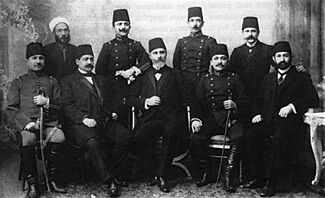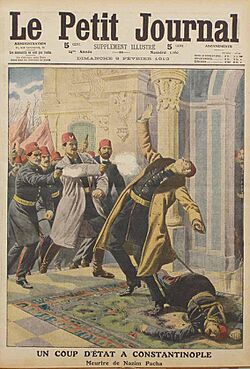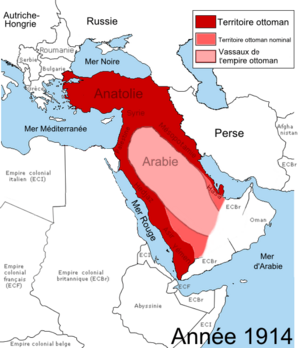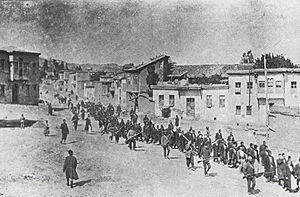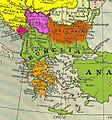Committee of Union and Progress facts for kids
Quick facts for kids
Union and Progress Party
اتحاد و ترقى فرقه سی
İttihad ve Terakki Fırkası |
|
|---|---|
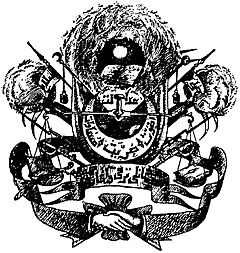 |
|
| Abbreviation | İ-T or İTC or İTF (in Turkish) CUP (in English) |
| Leader | Talaat Pasha (1908–1918) Ahmet Rıza (1897–1908) |
| Secretary-General | Mithat Şükrü Bleda (1911–1917) |
| Founders | Ibrahim Temo Mehmed Reshid Abdullah Cevdet İshak Sükuti Kerim Sebatî |
| Founded | 6 February 1889 (as an organization) |
| Dissolved | 1 November 1918 |
| Succeeded by | CHF A-RMHC OHAF TF |
| Headquarters | Pembe Konak, Nuruosmaniye, Constantinople, Ottoman Empire |
| Newspaper | Meşveret, Tanin and others |
| Paramilitary wing | Special Organization |
| Membership (1909 est.) | 850,000 |
| Ideology | İttihadism Constitutionalism Centralization Secularism Turkish nationalism Liberalism Scientific politics Ottomanism (until 1913) Pan-Turkism (after 1909) Ultranationalism (after 1913) Statism (after 1913) Pan-Islamism (after 1914) |
| Political position | Syncretic |
| Slogan | "Liberty, Equality, Justice" |
| Chamber of Deputies (1914) |
192 / 275
|
| Party flag | |
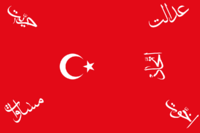 |
|
The Committee of Union and Progress (CUP), also known as the Society of Union and Progress, was a group of revolutionaries and a political party. It was active in the Ottoman Empire and later in the Republic of Turkey from 1889 to 1926. The CUP was a very important part of the Young Turks movement.
In 1908, the CUP started the Young Turk Revolution. This revolution ended the absolute rule of the Sultan and brought back a constitution. This began a new period called the Second Constitutional Era. From 1913 to 1918, the CUP took strong control of the empire. During this time, the CUP was responsible for terrible events that led to the mass killings and forced displacement of many Armenian, Greek, and Assyrian people. This was part of a plan to make Anatolia (modern-day Turkey) more Turkish.
People often called the CUP and its members "Young Turks." But there were other political groups in the Young Turk movement too. Within the Ottoman Empire, members were known as İttihadcılar (Unionists) or Komiteciler (Committeemen).
The CUP started as a group that wanted reforms and a constitution. Sultan Abdul Hamid II's government did not like them because they wanted a constitutional government. Many members were sent away or arrested after a failed attempt to take power in 1896. This led to disagreements among Young Turk groups living in Europe.
By 1906, the CUP became strong again, especially with new members from the army in Ottoman Macedonia. These members were fighting ethnic groups and believed that a constitution would help bring peace. In 1908, the Unionists revolted and made Sultan Abdul Hamid bring back the Constitution. This started a time of many political parties. The CUP's main rival was the Freedom and Accord Party. This party wanted the empire to be less centralized, while the CUP wanted a strong, unified Turkish state.
The CUP gained more power after the 1912 "Election of Clubs" and the 1913 Raid on the Sublime Porte. They became more nationalistic after losing the Balkan Wars. After the assassination of Grand Vizier Mahmud Şevket Pasha, a group of three CUP leaders, known as the Three Pashas (Talât Pasha, Enver Pasha, and Cemal Pasha), took control. They decided to join Germany in World War I. With the help of their special group, the Special Organization, the CUP government carried out policies that led to the destruction and forced removal of Armenian, Greek, and Assyrian citizens. This was done to make Anatolia more Turkish.
After the Ottoman Empire lost World War I, the CUP leaders fled to Europe. Many were later killed in Operation Nemesis as revenge for their actions. This included Talât and Cemal Pasha. Many CUP members were put on trial for war crimes. However, most former Unionists joined the Turkish National Movement led by Mustafa Kemal Atatürk. They continued their political careers in Turkey as members of Atatürk's Republican People's Party. The reforms started by the CUP were continued and expanded by Atatürk's party. This party ruled Turkey as a single party until 1946.
Contents
What Was the Committee of Union and Progress?
The CUP was first called "The Committee of the Ottoman Union." It was started in Constantinople (now Istanbul) on February 6, 1889. A group of medical students from the Imperial Military School of Medicine founded it.
One of the founders, Ahmet Rıza, was a big fan of ideas about progress. He changed the group's name to "The Committee of Union and Progress" (CUP). For a short time between 1906 and 1908, it was called the Committee of Progress and Union. But during the Young Turk Revolution, it changed back to the more famous Committee of Union and Progress.
The word cemiyet means "committee," "society," or "organization." The Young Turks admired the French Revolution and its political clubs. So, a good way to think of İttihad ve Terakki Cemiyeti is "The Society of Union and Progress." They wanted their movement to be like the Jacobin club in France.
In Europe, the CUP was often mixed up with the larger Young Turks movement. Its members were simply called Young Turks. But in the Ottoman Empire, a member was known as an İttihadçı (Unionist) or Komiteci (Committeeman). Their main idea was called İttihadçılık, or İttihadism (Unionism). The group's main leadership, the Central Committee, sometimes called itself the "Sacred Committee."
How the CUP Started

The Committee of Ottoman Union began as a secret group on June 2, 1889. It was founded by Ibrahim Temo, Dr. Mehmed Reşid, Abdullah Cevdet, and İshak Sükuti. They were all medical students in Constantinople. They believed that the Ottoman Empire needed a constitution to stop its decline.
Sultan Abdul Hamid II had brought in a constitution and a parliament in 1876. But he stopped them after the 1877-1878 war. From 1878 to 1908, Abdul Hamid ruled alone. The empire was in deep debt to European countries. Also, non-Muslim groups wanted their own nations. So, those who opposed the Sultan, called Young Turks, hoped to replace him with a constitutional government.
The Committee of Ottoman Union held its first meeting in a vineyard. They decided to organize themselves into secret groups, like the Italian Carbonari. They met every Friday to discuss ideas and read banned books. The group gained support from students in other colleges. Sultan Abdul Hamid II found out about them in 1890. Members were watched, arrested, and questioned. In 1894, some leaders were almost expelled from medical school but were pardoned. Soon, some members fled to Europe.
In 1894, a member named Mehmet "Doctor" Nazım went to Paris to recruit Ahmed Rıza Bey. Rıza soon led the Paris section of the group, which became the "Ottoman Committee of Union and Progress" (CUP). This group became the most important Young Turk faction. The CUP supported a failed attempt to overthrow the Sultan in 1895. This led to many arrests and exiles within the Ottoman Empire. Another plot in 1896 also failed, leading to more arrests and exiles.
The Young Turk Revolution
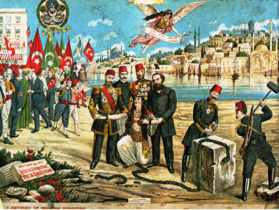
Sultan Abdul Hamid II tried to stop the Young Turks and keep his absolute power. But the CUP forced him to bring back the Ottoman constitution in 1908. This event is known as the Young Turk Revolution.
The revolution started suddenly. A rumor spread that Britain and Russia had secretly agreed to divide the Ottoman Empire. This rumor made the CUP's army branch in Monastir (now Bitola) act. Leaders like Enver and Ahmed Niyazi went to the mountains to gather support. The Unionists then carried out killings and threatened army officers. The revolt spread from the Third Army in Salonica to other armies.
Under pressure, on July 24, 1908, Abdul Hamid agreed to bring back the Constitution. People across the empire celebrated with parades. With the constitution and parliament back, an election was called for December. Many Young Turk groups became political parties, including the CUP.
After the revolution, many non-Turkish CUP members left the group. This was because different groups had different ideas about what constitutional rule meant. The revolution also led to the empire losing more land. Austria-Hungary took over Bosnia, Crete wanted to join Greece, and Bulgaria declared independence. The CUP responded by organizing a boycott of goods from Austria-Hungary.
The CUP in Power
The CUP successfully brought back democracy and a constitution. But they did not immediately take full control. Most of their members were junior officers and bureaucrats, and they didn't have much experience in running a country. The CUP decided to keep its secret nature. They sent a group of seven high-ranking Unionists to Constantinople to watch the government. Power was shared between the Sultan, the government, and the CUP's Central Committee, which was still based in Salonica.
The CUP's secret methods made some people accuse them of being authoritarian. In February 1909, the CUP showed its power. The Grand Vizier (like a prime minister) had to get approval from a CUP member for a new ambassador.
In April 1909, there was an uprising against the CUP and the new government. This event is called the 31 March Incident. Sultan Abdul Hamid II tried to use this to get his absolute power back. But CUP members and constitutionalist officers formed the "Action Army" and marched on Constantinople. They restored order and brought back the constitution. Abdul Hamid II was removed from power, and his younger brother, Mehmed V, became the new Sultan. Mehmed V agreed to be a constitutional monarch.
After this event, the CUP's power grew. In 1909, the Committee of Union and Progress officially became a public political party, the Union and Progress Party. It had 850,000 members and 360 branches. The party also started to include Pan-Turkism in its goals. This was the idea of uniting all Turkic people in the world. The CUP promised to be more open, but they still influenced politics secretly and sometimes used assassinations.
The CUP tried to make all Ottoman citizens equal. They reformed military service to include non-Muslims, which caused some upset. They also made Turkish the only language of instruction in schools and banned minority parties. The years after the 31 March Incident were less free, with more censorship and restrictions.
The 1913 Coup and Total Control
In September 1911, Italy invaded Ottoman Tripolitania (modern-day Libya). Many Unionist officers, including Enver and Mustafa Kemal, went to Libya to fight. This weakened the CUP's power at home. A new opposition party, Freedom and Accord, gained strength.
In the 1912 elections, the CUP used fraud and violence to win most of the seats. This election was known as the "Election of Clubs." This hurt the CUP's public image. In May 1912, a group of officers called the "Saviour Officers Group" demanded that the CUP-dominated parliament be dissolved. The CUP was forced out of power for a short time.
The First Balkan War started in October 1912. The Ottoman Empire lost much of its land in Europe, including the important city of Edirne. This was a huge defeat. The CUP was forced to move its headquarters to Istanbul.
To regain power, the CUP launched a surprise attack on the government, known as the Raid on the Sublime Porte, on January 23, 1913. During this coup, the Grand Vizier was forced to resign, and the War Minister, Nazım Pasha, was killed. The CUP said they acted to stop the government from giving up Edirne.
The CUP did not take over the government directly at first. But they had a lot of influence. They immediately restarted the war against Bulgaria to retake Edirne. The war continued with heavy losses. Finally, the empire signed a peace treaty in May 1913, losing almost all of its European land except Constantinople.
News of this failure led to a counter-coup attempt against the CUP. On June 11, Grand Vizier Mahmud Şevket Pasha was assassinated. With his death, the CUP took full control of the country. Any remaining opposition was crushed, and their leaders were exiled. The CUP now ruled the empire as a one-party state.
After the Second Balkan War started, the Ottomans attacked Bulgaria again. On July 21, 1913, Colonel Enver retook Edirne. This made him a national hero.
The CUP's Rule and World War I
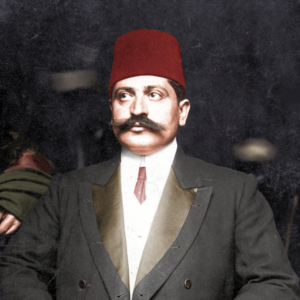
The CUP government became a dictatorship led by three powerful leaders, known as the Three Pashas: Talât (Interior Minister), Enver (War Minister), and Cemal (Naval Minister). These three men made most of the important decisions. Other important figures in the CUP also held great power.
The CUP regime was not as strict as some later dictatorships. Individual governors had a lot of freedom. Loyalty to the CUP was more important than skill. This led to a lack of clear rules and more corruption as time went on.
The loss of land in the Balkan Wars was very upsetting for the Ottomans. Many Muslims were forced to leave their homes. The CUP leaders, many of whom were from the Balkans, were deeply affected. They began to believe that the empire needed to focus on being Turkish. They thought that Christian groups in the empire might not be loyal.
The CUP started to promote "Turkish nationalism." They glorified the "Turkish race" and emphasized the idea of Turan, a mythical homeland of the Turks. They wanted Turks to be the main political and economic group in the empire. They also dreamed of uniting all Turkic peoples in a large pan-Turkic state.
Terrible Events During World War I
The CUP pushed the Ottoman Empire into World War I by secretly allying with Germany. They hoped to regain lost land and expand the empire. On August 2, 1914, the Ottoman and German governments signed a secret alliance. On October 29, Ottoman warships, secretly commanded by German officers, attacked Russian ports. Russia declared war on November 2, 1914. Britain and France declared war on November 5.
The CUP leaders hoped that the war would free the empire from foreign control. They ended old agreements that gave special rights to foreign powers. They also suspended reforms meant for Armenian provinces.
During World War I, the CUP began to see Armenians as a threat. Many Ottoman Armenians wanted to stay loyal to the empire. But some CUP leaders believed they might side with Russia. In early 1915, the CUP-controlled newspapers still said Armenians were important to the war effort. However, tensions grew.
After a major defeat against Russia in the Battle of Sarikamish, the CUP's dreams of expanding into Central Asia ended. This made them more determined to make Anatolia a purely Turkish homeland.
Forced Removals and Mass Killings
From 1915 to 1918, the Ottoman Empire, under the CUP's control, carried out terrible actions against about 1 million Armenians and other Christian groups. This period is known as the Late Ottoman Genocides. Talât Pasha, as Interior Minister, was key in organizing these events. The CUP also wanted to remove Greek people from western Anatolia, but Germany, their ally, stopped this because they wanted Greece to remain neutral.
The Special Organisation, a group of very loyal CUP members, played a big part in these events. They were expanded in 1914. Talât ordered that prisoners convicted of serious crimes could be freed if they joined this group to kill Armenians and take their property. Many criminals, Kurdish tribesmen, and refugees from the Balkans joined, seeking revenge against Christians.
In late 1914, Enver Pasha ordered that all Armenian soldiers in the Ottoman Army be disarmed and sent to labor groups. The next year, he ordered the killing of these 200,000 Armenian soldiers.
On April 24, 1915, Talât ordered the deportation of Armenians to the harsh deserts of northern Syria. That night, many important Armenian leaders in Constantinople were arrested and killed. The CUP spread false stories about Armenians to create anger. On May 27, a law was passed that allowed the government to deport people if national security was at risk.
Armenians who were forced to leave had their property taken by the state. This property was then given to Muslims or taken by local officials. By late 1916, most Armenians outside of major cities like Constantinople and Izmir had lost their private property. In areas where Christians were removed, the government settled Muslim refugees from the Balkans. This plan to redistribute Armenian property was a main part of the CUP's goal to make Anatolia Turkish.
The CUP's actions against Armenians and other Christian groups were on a much larger scale than anything before. However, similar forced removals had happened in the past.
The Assyrian Christian community was also targeted. Talât ordered the removal of Assyrians from Hakkâri, leading to the deaths of hundreds of thousands. However, this policy was not carried out across the entire empire.
Even though some Kurdish tribes helped in these actions against Christians, Kurds themselves were also victims of forced removals, though not mass killings. Talât wanted the Kurdish population in some areas to be no more than 5%. Balkan Muslim and Turkish refugees were settled in Kurdish areas, and some Kurds were moved to Central Anatolia. Many Kurds died from hunger due to poor planning during these removals.
The CUP was against any group that might want independence. Cemal Pasha, who governed Syria, also used forced removals against some Arab families he suspected of disloyalty. During the war, a severe famine affected parts of Syria due to blockades and lack of supplies.
The forced removals of Greeks were paused for a while because Germany wanted Greece to stay neutral. But after Russia's advances and signs that Greece might join the Allies, the CUP resumed operations against the Greeks living on the Black Sea coast. Talât ordered the forced removal of the Pontus Greeks.
End of the CUP and Its Legacy

As the Central Powers (including the Ottoman Empire) began to lose World War I, Talât Pasha's government resigned on October 13, 1918. On October 30, the Ottoman Empire signed an agreement to stop fighting. The CUP's position was no longer strong, and its top leaders fled the country.
At its last meeting in November 1918, the remaining CUP members decided to close down the party. But a week later, a new party called the Renewal Party was created, taking over most of the CUP's resources. Later, the Ottoman Liberal People's Party was also formed by former Unionists. Both were banned by the Ottoman government in 1919.
After the war, the Allied powers helped Ottoman officials remove Unionists from the government and army. British forces occupied Constantinople and demanded that CUP leaders responsible for atrocities be put on trial. Many high-ranking Unionists were sent to Malta for trials. The new Ottoman government arrested over 100 Unionist officials. Some were executed for crimes against humanity.
Many CUP leaders who fled were later assassinated between 1920 and 1922 in Operation Nemesis. Armenian groups sent assassins to hunt down and kill those responsible for the terrible events against Armenians. Talât Pasha was killed in Berlin in 1921. Cemal Pasha was killed in Tbilisi in 1922. Enver Pasha was killed in Central Asia while leading a revolt.
Most Unionists joined Mustafa Kemal Atatürk and his Turkish National Movement to fight against the Allied occupation. Many former Unionists became important figures in the new Republic of Turkey. Presidents like Mustafa Kemal Atatürk, İsmet İnönü, and Celal Bayar were all former CUP members. The reforms started by the CUP, such as those in women's rights and education, laid the groundwork for Atatürk's later reforms.
Some historians in Turkey say that the Ottoman Empire and the Republic of Turkey are completely separate. They also say that the CUP and Atatürk's Republican People's Party are unrelated. However, because many of the same people and ideas continued, others argue that there was a strong connection between the CUP's rule and the early years of the Republic of Turkey.
The Young Turk Revolution and the CUP's actions also influenced other countries. For example, Muslims in India and Central Asia were inspired by the Young Turks. In Greece, military officers formed a secret group like the CUP and overthrew their government.
The CUP regime is sometimes seen as the world's first one-party state. It set an example for other one-party governments that appeared in Europe later on.
Images for kids
-
Abdul Hamid II at Selanik, where he was exiled after his dethronement in the 31 March Incident.
-
Propaganda postcard with the atrocities of Bulgarian and Greek troops over the Muslim populations during the Balkan Wars.
-
Ziya Gökalp, a key thinker of the committee.
-
The Revenge Map, published by the Society of Muslim Refugees from Rumeliya. In black is the part of the Ottoman Empire lost during the Balkan Wars from which many Muhacirs fled.
-
Enver Pasha, the Minister of War.
-
Talât with CUP leaders Halil Bey and Enver Pasha, and Zionist politician Alfred Nossig, 1915.
-
Unionist Shaykh-al-Islam Mustafa Hayri delivering Mehmed V's Declaration of Holy War.
-
Central Powers' delegation to Brest Litovsk; from left to right: General Max Hoffman (Germany), Ottakar Czernin (Austrian Minister of Foreign Affairs), Grand Vizier Talât Pasha, and Richard von Kühlmann (German Minister of Foreign Affairs).
See also
- Tanin (newspaper)
- Kemalism
- Persecution of Muslims during Ottoman contraction
- Persecution of Christians in the later Ottoman Empire
- List of Ottoman grand viziers of the Second Constitutional Era
- List of political parties in the Ottoman Empire


